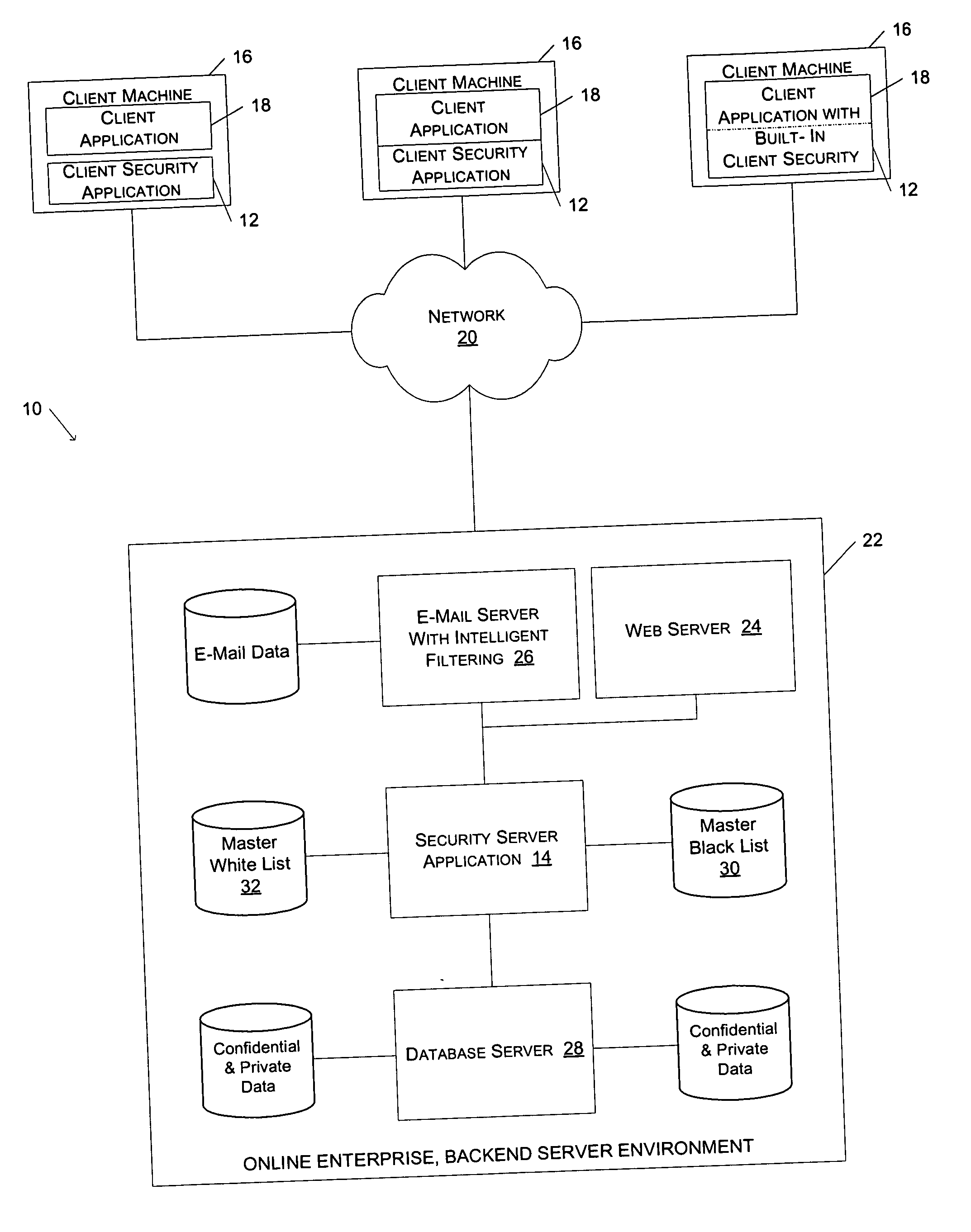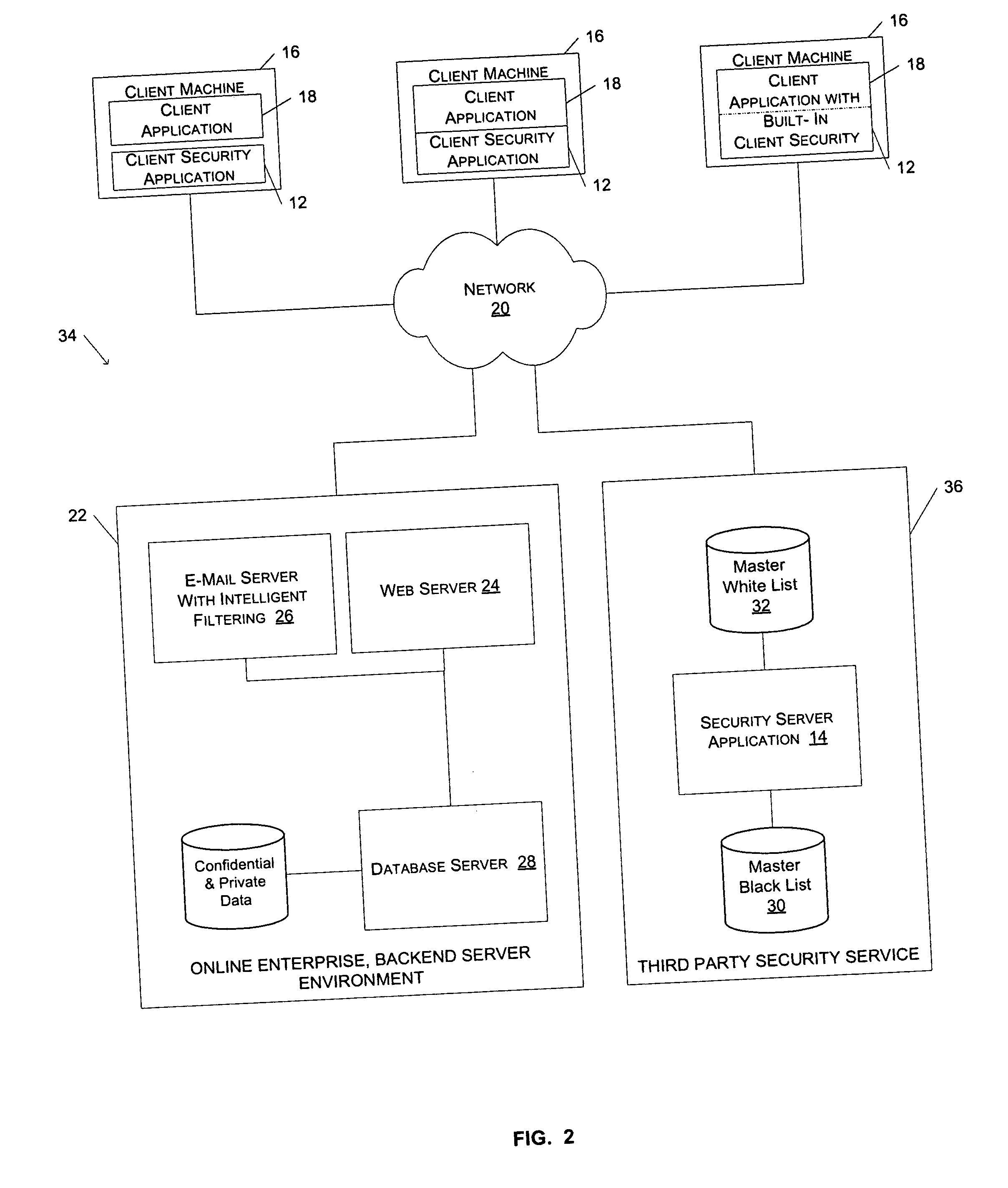[0021] One
advantage of the present invention is that it provides a simple and effective way for novice and advanced
Internet users to detect, and thereby avoid interaction with, spoof web sites. For one embodiment of the present invention, a
client toolbar application executes on a user's PC in conjunction with a
web browser application. The client
toolbar application includes a universal resource locator, or URL,
comparator module to compare the URL of a recently downloaded document to the URLs in a list of URLs associated with known spoof sites. If the
comparator module determines that the URL of the recently downloaded document matches a URL listing in the list of URLs associated with known spoof sites, a visual display indicator module displays a security warning on the
toolbar to warn the user that he or she is viewing a spoof site.
[0022] In another embodiment of the present invention, a client toolbar application executes on a user's PC in conjunction with a
web browser application. The client toolbar application includes a
comparator module to compare the URL of a downloaded document with the URLs in a list of URLs associated with known trusted sites. If the comparator module determines that the URL of the downloaded document matches a URL in the list of trusted sites, a visual display indicator indicates to the user that the downloaded document is associated with a trusted site.
[0023] An embodiment of the present invention is also advantageous for its ability to detect when a user is submitting a
password associated with a particular account, to a
server not associated with that account. For example, one embodiment of the invention includes a
password detection module that detects when a password is being submitted to a
server. If the password is known to be associated with a particular account, and the server to which the password is being submitted is not associated with that particular account, then the password detection module warns the user that he is submitting a password associated with a particular account to a server not associated with the account.
[0024]FIG. 1 illustrates a client-server network environment 10 including a client security application 12 and a security server application 14, consistent with an embodiment of the present invention. The client-server network environment 10 illustrated in FIG. 1 includes three client machines 16 connected via a network 20 to various servers in a backend server environment 22. Each
client machine 16 is capable of executing a client application 18 that facilitates the browsing of documents hosted and served by the
web server 24 of the backend server environment 22. For one embodiment of the present invention, the client security application 12 operates in conjunction with a client application 18 to help users identify spoof sites and trusted sites while browsing documents via the network 20. For example, the client application 18 may be a web browser application, such as Microsoft Internet Explorer®. By entering a universal resource locator (URL) into the
address bar of the web browser, a user is able to download and view documents that are served by the
web server 24. For each document the user downloads via the web browser 18, the client security application 12 displays a security indicator to indicate a security
ranking for the document. For purposes of the present invention, the term “document” is used to describe any file produced by an application, such as an audio file, an email, a video file, or a
web page.
[0025] In addition to the
web server 24, the backend server environment 22 includes an e-mail server 26, a
database server 28, and a security server application 14. The
database server 28 controls and maintains user account data that is accessible to users via documents served by web server 24. As described in greater detail below, the security server application 14 operates in conjunction with the client security application 12 to ensure that the client security application has a current list of spoof sites and trusted sites.
[0026] As illustrated in FIG. 1, the client security application 12 may be a stand-alone application, or it may be dynamically linked to the client application 18. Alternatively, the client security application 12 may be a tightly integrated subcomponent of the client application 18. For one embodiment of the invention, the client security application 12 appears as a toolbar that is attachable to a window of a web browser application 18. In an alternative embodiment of the invention, the
user interface of the client security application 12 may vary. For example, the client security application 12 may appear in the
system tray of a windowing
operating system, or as one or more pop-up windows. Alternatively, the the client security application may run in the background, completely behind the scenes with no UI, and only display a warning when a potential spoof site is detected.
 Login to View More
Login to View More 


